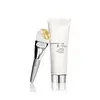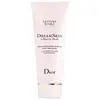What's inside
What's inside
 Key Ingredients
Key Ingredients

 Benefits
Benefits

 Concerns
Concerns

 Ingredients Side-by-side
Ingredients Side-by-side

Propylene Glycol
HumectantGlycerin
HumectantWater
Skin ConditioningGlycereth-26
HumectantSynthetic Fluorphlogopite
Phaseolus Radiatus Seed Extract
Skin ConditioningParfum
MaskingPanthenol
Skin ConditioningAmmonium Acryloyldimethyltaurate/Vp Copolymer
Sclerotium Gum
Emulsion Stabilising3-O-Ethyl Ascorbic Acid
Skin ConditioningDisodium Adenosine Triphosphate
Skin ConditioningLaminaria Digitata Extract
Skin ProtectingCentaurea Cyanus Flower Extract
AstringentTocopherol
AntioxidantButylene Glycol
HumectantMethylpropanediol
SolventEthylhexylglycerin
Skin ConditioningMagnesium Aspartate
Skin ConditioningDehydroacetic Acid
PreservativePhenoxyethanol
PreservativeCitric Acid
BufferingTetrasodium EDTA
Benzyl Alcohol
PerfumingTin Oxide
AbrasiveSodium Hydroxide
BufferingLinalool
PerfumingCI 77891
Cosmetic ColorantPropylene Glycol, Glycerin, Water, Glycereth-26, Synthetic Fluorphlogopite, Phaseolus Radiatus Seed Extract, Parfum, Panthenol, Ammonium Acryloyldimethyltaurate/Vp Copolymer, Sclerotium Gum, 3-O-Ethyl Ascorbic Acid, Disodium Adenosine Triphosphate, Laminaria Digitata Extract, Centaurea Cyanus Flower Extract, Tocopherol, Butylene Glycol, Methylpropanediol, Ethylhexylglycerin, Magnesium Aspartate, Dehydroacetic Acid, Phenoxyethanol, Citric Acid, Tetrasodium EDTA, Benzyl Alcohol, Tin Oxide, Sodium Hydroxide, Linalool, CI 77891
Water
Skin ConditioningGlycerin
HumectantPolysorbate 20
EmulsifyingGlycolic Acid
BufferingButylene Glycol
HumectantHydroxyethyl Acrylate/Sodium Acryloyldimethyl Taurate Copolymer
Emulsion StabilisingCI 77891
Cosmetic ColorantHydrogenated Polyisobutene
EmollientAlcohol
AntimicrobialCitric Acid
BufferingSodium Hydroxide
BufferingSimmondsia Chinensis Seed Oil
EmollientParfum
MaskingXanthan Gum
EmulsifyingDipotassium Glycyrrhizate
HumectantPhenoxyethanol
PreservativeXylitol
HumectantPolysorbate 60
EmulsifyingSorbitan Isostearate
EmulsifyingTetrasodium EDTA
Ascorbyl Glucoside
AntioxidantSynthetic Fluorphlogopite
Malva Sylvestris Extract
AstringentHibiscus Sabdariffa Flower Extract
Skin ConditioningZea Mays Starch
AbsorbentHydrogenated Lecithin
EmulsifyingSaponins
CleansingLimonene
PerfumingPentaerythrityl Tetra-Di-T-Butyl Hydroxyhydrocinnamate
AntioxidantAframomum Angustifolium Seed Extract
Skin ConditioningPalmaria Palmata Extract
Skin ProtectingSodium Benzoate
MaskingTin Oxide
AbrasivePotassium Sorbate
PreservativeTocopherol
AntioxidantJasminum Officinale Flower Extract
MaskingCI 14700
Cosmetic ColorantWater, Glycerin, Polysorbate 20, Glycolic Acid, Butylene Glycol, Hydroxyethyl Acrylate/Sodium Acryloyldimethyl Taurate Copolymer, CI 77891, Hydrogenated Polyisobutene, Alcohol, Citric Acid, Sodium Hydroxide, Simmondsia Chinensis Seed Oil, Parfum, Xanthan Gum, Dipotassium Glycyrrhizate, Phenoxyethanol, Xylitol, Polysorbate 60, Sorbitan Isostearate, Tetrasodium EDTA, Ascorbyl Glucoside, Synthetic Fluorphlogopite, Malva Sylvestris Extract, Hibiscus Sabdariffa Flower Extract, Zea Mays Starch, Hydrogenated Lecithin, Saponins, Limonene, Pentaerythrityl Tetra-Di-T-Butyl Hydroxyhydrocinnamate, Aframomum Angustifolium Seed Extract, Palmaria Palmata Extract, Sodium Benzoate, Tin Oxide, Potassium Sorbate, Tocopherol, Jasminum Officinale Flower Extract, CI 14700
Ingredients Explained
These ingredients are found in both products.
Ingredients higher up in an ingredient list are typically present in a larger amount.
Butylene Glycol (or BG) is used within cosmetic products for a few different reasons:
Overall, Butylene Glycol is a safe and well-rounded ingredient that works well with other ingredients.
Though this ingredient works well with most skin types, some people with sensitive skin may experience a reaction such as allergic rashes, closed comedones, or itchiness.
Learn more about Butylene GlycolCi 77891 is a white pigment from Titanium dioxide. It is naturally found in minerals such as rutile and ilmenite.
It's main function is to add a white color to cosmetics. It can also be mixed with other colors to create different shades.
Ci 77891 is commonly found in sunscreens due to its ability to block UV rays.
Learn more about CI 77891Citric Acid is an alpha hydroxy acid (AHA) naturally found in citrus fruits like oranges, lemons, and limes.
Like other AHAs, citric acid can exfoliate skin by breaking down the bonds that hold dead skin cells together. This helps reveal smoother and brighter skin underneath.
However, this exfoliating effect only happens at high concentrations (20%) which can be hard to find in cosmetic products.
Due to this, citric acid is usually included in small amounts as a pH adjuster. This helps keep products slightly more acidic and compatible with skin's natural pH.
In skincare formulas, citric acid can:
While it can provide some skin benefits, research shows lactic acid and glycolic acid are generally more effective and less irritating exfoliants.
Most citric acid used in skincare today is made by fermenting sugars (usually from molasses). This synthetic version is identical to the natural citrus form but easier to stabilize and use in formulations.
Read more about some other popular AHA's here:
Learn more about Citric AcidGlycerin is already naturally found in your skin. It helps moisturize and protect your skin.
A study from 2016 found glycerin to be more effective as a humectant than AHAs and hyaluronic acid.
As a humectant, it helps the skin stay hydrated by pulling moisture to your skin. The low molecular weight of glycerin allows it to pull moisture into the deeper layers of your skin.
Hydrated skin improves your skin barrier; Your skin barrier helps protect against irritants and bacteria.
Glycerin has also been found to have antimicrobial and antiviral properties. Due to these properties, glycerin is often used in wound and burn treatments.
In cosmetics, glycerin is usually derived from plants such as soybean or palm. However, it can also be sourced from animals, such as tallow or animal fat.
This ingredient is organic, colorless, odorless, and non-toxic.
Glycerin is the name for this ingredient in American English. British English uses Glycerol/Glycerine.
Learn more about GlycerinParfum is a catch-all term for an ingredient or more that is used to give a scent to products.
Also called "fragrance", this ingredient can be a blend of hundreds of chemicals or plant oils. This means every product with "fragrance" or "parfum" in the ingredients list is a different mixture.
For instance, Habanolide is a proprietary trade name for a specific aroma chemical. When used as a fragrance ingredient in cosmetics, most aroma chemicals fall under the broad labeling category of “FRAGRANCE” or “PARFUM” according to EU and US regulations.
The term 'parfum' or 'fragrance' is not regulated in many countries. In many cases, it is up to the brand to define this term.
For instance, many brands choose to label themselves as "fragrance-free" because they are not using synthetic fragrances. However, their products may still contain ingredients such as essential oils that are considered a fragrance by INCI standards.
One example is Calendula flower extract. Calendula is an essential oil that still imparts a scent or 'fragrance'.
Depending on the blend, the ingredients in the mixture can cause allergies and sensitivities on the skin. Some ingredients that are known EU allergens include linalool and citronellol.
Parfum can also be used to mask or cover an unpleasant scent.
The bottom line is: not all fragrances/parfum/ingredients are created equally. If you are worried about fragrances, we recommend taking a closer look at an ingredient. And of course, we always recommend speaking with a professional.
Learn more about ParfumPhenoxyethanol is a preservative that has germicide, antimicrobial, and aromatic properties. Studies show that phenoxyethanol can prevent microbial growth. By itself, it has a scent that is similar to that of a rose.
It's often used in formulations along with Caprylyl Glycol to preserve the shelf life of products.
Sodium Hydroxide is also known as lye or caustic soda. It is used to adjust the pH of products; many ingredients require a specific pH to be effective.
In small amounts, sodium hydroxide is considered safe to use. However, large amounts may cause chemical burns due to its high alkaline.
Your skin has a natural pH and acid mantle. This acid mantle helps prevent harmful bacteria from breaking through. The acid mantle also helps keep your skin hydrated.
"Alkaline" refers to a high pH level. A low pH level would be considered acidic.
Learn more about Sodium HydroxideSynthetic Fluorphlogopite is the synthethic version of mica. It consists of fluorine, aluminum and silicate.
Synthetic Fluorphlogopite is used to add volume to products.
It is considered non-irritating on the skin.
Learn more about Synthetic FluorphlogopiteTetrasodium EDTA is the salt formed from neutralizing ethylenediamine tetraacetic acid with sodium hydroxide. It is a chelating agent and used to prevent metal ions from binding to other ingredients. This helps keep the product and ingredients stable.
Tetrasodium EDTA comes as a white solid and is soluble in water.
Tin Oxide is an inorganic oxide used to add opacity and volume to a product. In nature, it is already found in mineral form. The main ore of tin is an opaque and shiny mineral called casseterite.
Tin Oxide helps remove translucency in a product, or make it more opaque. Besides adding opacity, tin oxide is used for bulking to add volume.
Tocopherol (also known as Vitamin E) is a common antioxidant used to help protect the skin from free-radicals and strengthen the skin barrier. It's also fat soluble - this means our skin is great at absorbing it.
Vitamin E also helps keep your natural skin lipids healthy. Your lipid skin barrier naturally consists of lipids, ceramides, and fatty acids. Vitamin E offers extra protection for your skin’s lipid barrier, keeping your skin healthy and nourished.
Another benefit is a bit of UV protection. Vitamin E helps reduce the damage caused by UVB rays. (It should not replace your sunscreen). Combining it with Vitamin C can decrease sunburned cells and hyperpigmentation after UV exposure.
You might have noticed Vitamin E + C often paired together. This is because it is great at stabilizing Vitamin C. Using the two together helps increase the effectiveness of both ingredients.
There are often claims that Vitamin E can reduce/prevent scarring, but these claims haven't been confirmed by scientific research.
Learn more about TocopherolWater. It's the most common cosmetic ingredient of all. You'll usually see it at the top of ingredient lists, meaning that it makes up the largest part of the product.
So why is it so popular? Water most often acts as a solvent - this means that it helps dissolve other ingredients into the formulation.
You'll also recognize water as that liquid we all need to stay alive. If you see this, drink a glass of water. Stay hydrated!
Learn more about Water